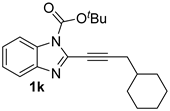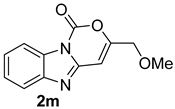Abstract
A straightforward approach to new polycyclic heterocycles, 1H-benzo[4,5]imidazo[1,2-c][1,3]oxazin-1-ones, is presented. It is based on the ZnCl2-promoted deprotective 6-endo-dig heterocyclization of N-Boc-2-alkynylbenzimidazoles under mild conditions (CH2Cl2, 40 °C for 3 h). The zinc center plays a dual role, as it promotes Boc deprotection (with formation of the tert-butyl carbocation, which can be trapped by substrates bearing a nucleophilic group) and activates the triple bond toward intramolecular nucleophilic attack by the carbamate group. The structure of representative products has been confirmed by X-ray diffraction analysis.
1. Introduction
The development of efficient methods for the synthesis of high value added polycyclic heterocyclic derivatives by metal-promoted annulation of acyclic precursors is one of the most important area of research in heterocyclic chemistry [1,2,3,4,5]. Polycyclic heterocyclic systems, in fact, are largely present as fundamental cores in natural products and in biologically active compounds [6,7,8,9,10,11], and the possibility to obtain them by a simple cyclization process starting from readily available substrates is particularly attractive [1,2,3,4,5].
Among acyclic substrates able to undergo a metal-promoted cyclization to give a polycyclic heterocycle, functionalized alkynes bearing a suitably placed heteronucleophile play a major role, as the triple bond can be easily electrophilically activated by a suitable metal species thus promoting the cyclization by intramolecular nucleophilic attack [1,2,3,4,5]. Usually, processes like these are promoted by costly metals (mainly gold [12,13,14,15,16,17,18,19], palladium [20,21,22,23], rhodium [24,25,26], platinum [27,28,29], and, occasionally, ruthenium [30]), while the use of less expensive metal species, such as cobalt [31], nickel [32], copper [33,34,35,36], zinc [37,38,39,40], and silver [41,42] compounds, has been scantly reported in the literature, and applied to a limited number of examples.
In this work, we report on the use of very simple and inexpensive ZnCl2 as a promoter for the efficient deprotective heterocyclization of N-Boc-2-alkynylbenzimidazoles 1, to give access to novel polycyclic heterocycles, that are, 1H-benzo[4,5]imidazo[1,2-c][1,3]oxazin-1-ones 2 (Scheme 1). It is worth mentioning in this context that the cyclization of O-Boc propargyl alcohols to give 4H-1,3-dioxin-2-ones and/or 4-alkylidene-1,3-dioxolan-2-ones has been previously reported to occur with mercuric triflate as the catalyst [43]. It is also important to note that some excellent reviews on Zn-catalyzed reactions have appeared in the recent literature [44,45,46,47,48].

Scheme 1.
This work: ZnCl2-assisted heterocyclization of N-Boc-alkynylbenzimidazoles 1 to benzimidazoxaxinones 2.
2. Results and Discussion
It is well known that zinc (II) compounds are able to promote Boc deprotection [49,50,51,52,53,54]. In particular, an excess of ZnBr2 has been successfully employed for the deprotection of N-Boc secondary amines [52] as well as of tert-butyl esters [53,54]. Considering the importance of developing new approaches to the synthesis of polycyclic heterocycles by heterocyclization processes promoted by non-noble and inexpensive metal species, we have explored the possibility to access new polycyclic heterocycles, that are 1H-benzo[4,5]imidazo[1,2-c][1,3]oxazin-1-ones 2, starting from readily available N-Boc-2-alkynylbenzimidazoles 1, by Zn(II)-assisted deprotective heterocyclization (Scheme 1). According to our rationale, the zinc center should play a double role, that is, to promote deprotection to give a carbamate species A (with elimination of isobutene and H+ from the ensuing tert-butyl carbocation [52,53,54]) and then assist a 6-endo-dig heterocyclization by intramolecular nucleophilic attack of the free carbamate group of species B (in equilibrium with A) on the triple bond activated by coordination to Zn2+ (with the zinc center stabilized by chelation by the benzimidazole nitrogen). This would lead to organizinc intermediate C, whose protonolysis would then afford the polycyclic heterocycles 2 (Scheme 2; zinc counteranions have been omitted for clarity).
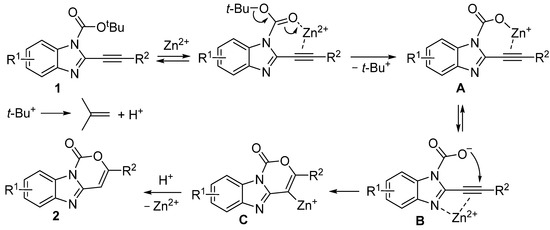
Scheme 2.
Mechanistic hypothesis for the formation of polycyclic heterocycles 2 by Zn2+‒mediated sequential deprotection ‒ 6-endo-dig heterocyclization of N-Boc-alkynylbenzimidazoles 1.
The first experiments were performed using N-Boc-2-(hex-1-in-1-yl)-1H-benzo[d]imidazole 1a as substrate (R1 = H, R2 = Bu) (prepared by alkynylation of N-Boc-2-bromo-1H-benzo[d]imidazole, see the Supplementary Materials for details), which was allowed to react in CH2Cl2 as the solvent at room temperature in the presence of ZnBr2 (1 equiv). Under these conditions, after 3 h reaction time, substrate conversion was 51%, while the desired 3-butyl-1H-benzo[4,5]imidazo[1,2-c][1,3]oxazin-1-one 2a was isolated in 25% yield. The structure of 2a was unequivocally confirmed by XRD analysis (see the Supplementary Materials for XRD data). The X-ray structure of 2a, shown in Figure 1, confirmed that the heterocyclization process at intermediate B level occurred in a 6-endo-dig fashion (with closure to a 6-membered ring) rather than in the possible alternative 5-exo-dig fashion (with closure to a five-membered ring).
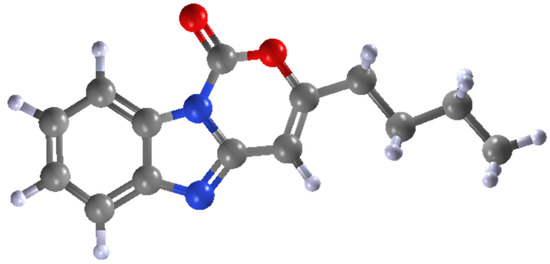
Figure 1.
Molecular structure of 3-butyl-1H-benzo[4,5]imidazo[1,2-c][1,3]oxazin-1-one 2a. Color legend: carbon (light grey), hydrogen (white), oxygen (red), nitrogen (blue) (CCDC 2050576).
In spite of the low yield, this initial result was encouraging, since it confirmed the validity of our work hypothesis and the possibility to synthesize novel polycyclic heterocycles with a very simple approach and using an inexpensive promoter. In order to improve the reaction performance, and achieve a higher 2a yield, we then changed some operative parameters (Table 1, entries 2–9). Practically no reaction occurred by changing the solvent to MeOH (Table 1, entry 2), while only traces of 2a were detected in acetone (Table 1, entry 3). Lowering the amount of ZnBr2 significantly suppressed the reaction (Table 1, entry 4). On the other hand, the use of 1.5 or 2 equiv of ZnBr2 was beneficial, 2a being formed in ca. 70% isolated yield (Table 1, entries 5 and 6, respectively). Better results with respect to the parent reaction (Table 1, entry 1) were also obtained by increasing the 1a concentration from 0.5 (Table 1, entry 1) to 1 mmol/mL of CH2Cl2 (Table 1, entry 7), while more diluted conditions led to a lower 2a yield (Table 1, entry 8). Predictably, a faster reaction was observed at 40 °C rather than 25 °C, with a higher yield of 2a (Table 1, entry 9) with respect to the initial experiment (Table 1, entry 1). Under the optimized conditions (40 °C in CH2Cl2 in the presence of 1.5 equiv of ZnBr2, with a substrate concentration of 1 mmol per mL of solvent), 2a could be finally obtained in a yield as high as 79% (Table 1, entry 10).

Table 1.
ZnX2-promoted deprotective heterocyclization of N-Boc-2-(hex-1-in-1-yl)-1H-benzo[d]imidazole 1a under different conditions a.
Very interestingly, the reaction was also successful using ZnCl2 (Table 1, entry 11) or ZnI2 (Table 1, entry 12), the best results in terms of 2a yield being obtained with ZnCl2 (82%, Table 1, entry 11). This result, associated with the lower cost of ZnCl2, made ZnCl2 the promoter of choice for realizing the transformation of 1a into benzimidazoxazinone 2a and for the subsequent extension to other differently substituted substrates (Table 2). Thus, to assess the generality of the reaction, various N-Boc-alkynylbenzimidazoles 1 (bearing different R1 and R2 groups; prepared as detailed in the Supplementary Materials) were subjected to the optimized reaction conditions with ZnCl2 as the promoter (Table 2, entries 2–15).

Table 2.
Synthesis of 1H-benzo[4,5]imidazo[1,2-c][1,3]oxazin-1-ones 2 by ZnCl2-promoted deprotective heterocyclization of N-Boc-2-alkynylbenzimidazoles 1 a.
As can be seen from Table 2, entries 2–5, excellent results were obtained with substrates still with R2 = Bu and bearing either electron-donating (methyl or methoxy; yields of the corresponding products 2b–d were 76–83%, Table 2, entries 2–4) or electron-withdrawing chlorine substituents (yield of 2e = 77%, Table 2, entry 5) on the aromatic ring. On the other hand, inferior results were observed with substrates 1f and 1g, bearing a strong electron-withdrawing nitro substituent (yields of 2f and 2g were 45% and 30%, Table 2, entries 6 and 7, respectively). With these substrates, complete Boc removal competed with heterocyclization, as confirmed by the formation of not negligible amounts of deprotected compounds 3f and 3g (20% and 31%, respectively, Table 2, entries 6 and 7) (Scheme 3), not observed in other cases. Clearly, the formation of these byproducts from substrates 1f and 1g is due to the diminished nucleophilicity of the carbamate intermediate B (Scheme 2) caused by the strong electron-withdrawing effect of the nitro group, which makes decarboxylation to compete with cyclization. The structures of products 2c and 2f were confirmed by XRD analysis (see the Supplementary Materials for XRD data). The X-ray structures of 2c and 2f, shown in Figure 2 and Figure 3, respectively, allowed to unequivocally establish the positions of the methoxy and nitro substituents in regioisomeric substrates 1c/1d and 1f/1g, respectively (as 2c must be formed from 1c and 2f from 1f).
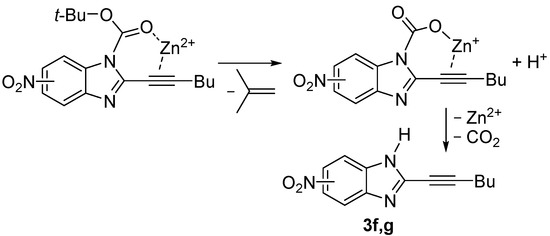
Scheme 3.
Formation of byproducts 3f and 3g (Table 2, entries 6 and 7) by Boc deprotection of nitro-substituted substrates 1f and 1g, competitive with heterocyclization.
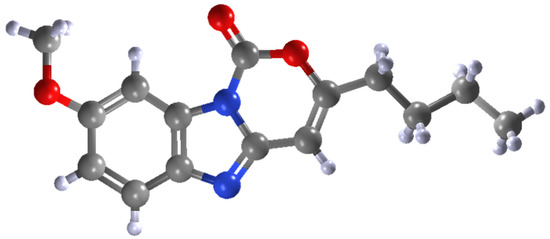
Figure 2.
Molecular structure of 3-butyl-8-methoxy-1H-benzo[4,5]imidazo[1,2-c][1,3]oxazin-1-one 2c. Color legend: carbon (light grey), hydrogen (white), oxygen (red), nitrogen (blue) (CCDC 2051334).
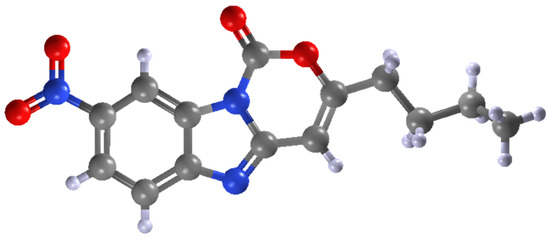
Figure 3.
Molecular structure of 3-butyl-8-nitro-1H-benzo[4,5]imidazo[1,2-c][1,3]oxazin-1-one 2f. Color legend: carbon (light grey), hydrogen (white), oxygen (red), nitrogen (blue) (CCDC 2050711).
High yields of the corresponding benzimidazoxazinones were obtained by changing the alkyl substituent on the triple bond R2 to octyl (yield of 2h, 85%; Table 2, entry 8), isopentyl (yield of 2i, 82%; Table 2, entry 9), or phenethyl (yield of 2j, 80%; Table 2, entry 10), while a slightly lower yield was observed with R2 = cyclohexylmethyl (yield of 2k, 70%; Table 2, entry 11). The use of a substrate with the triple bond conjugated with an alkenyl group, as in N-Boc-2-(cyclohex-1-en-1-ylethynyl)-1H-benzo[d]imidazole 1l, led to a satisfactory yield of the corresponding polycyclic heterocycle 2l (66%; Table 2, entry 12).
The method also worked nicely with substrates bearing a functionalized alkyl chain of the triple bond, as shown by the results obtained with a methoxymethyl (yield of 2m, 60%; Table 2, entry 13) or a 2-(methoxycarbonyl) ethyl (yield of 2n, 74%; Table 2, entry 14) group. Interestingly in the case of N-Boc-4-(1H-benzo[d]imidazol-2-yl) but-3-yn-1-ol 1o, bearing a 2-hydroxyethyl group on the triple bond, the tert-butyl group was incorporated into the final product to give 3-(2-(tert-butoxy)ethyl)-1H-benzo[4,5]imidazo[1,2-c][1,3]oxazin-1-one 2o’ (66% yield; Table 1, entry 15). This is clearly due to the trapping of the tert-butyl carbocation, ensuing from deprotection, by the nucleophilic hydroxyl group, as shown in Scheme 4.
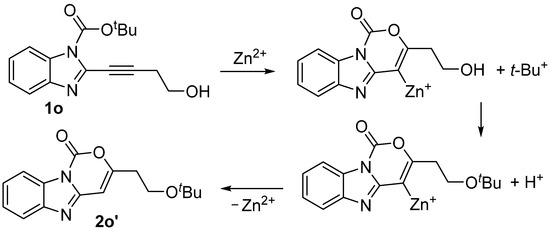
Scheme 4.
Plausible mechanism for the formation of product 2o’ (chloride anions are omitted for clarity).
3. Materials and Methods
3.1. General Experimental Methods
Melting points were measured with a Leitz Laborlux 12 POL polarizing optical microscope (Leitz Italia GmbH/Srl, Lana(BZ), Italy) and are uncorrected. 1H NMR and 13C NMR spectra were recorded at 25 °C in CDCl3 or DMSO-d6 at 300 MHz or 500 MHz and 75 or 125 MHz, respectively, with Me4Si as internal standard, using Bruker DPX Avance 300 and Bruker DPX Avance 500 NMR spectrometers (Brucker Italia s.r.l., Milano, Italy); chemical shifts (δ) and coupling constants (J) are given in ppm and in Hz, respectively. IR spectra were taken with a JASCO FT-IR 4200 spectrometer (Jasco Europe s.r.l., Cremella, Lecco, Italy). All reactions were analyzed by TLC on silica gel 60 F254 and by GC-MS using a Shimadzu QP-2010 GC–MS apparatus (Smimadzu Italia s.r.l., Milano, Italy) at 70 eV ionization voltage equipped with a 95% methyl polysiloxane–5% phenyl polysiloxane capillary column (30 m × 0.25 mm, 0.25 μm). Column chromatography was performed on silica gel 60 (Merck, 70–230 mesh; Merck Life Science s.r.l., Milano, Italy). Evaporation refers to the removal of solvent under reduced pressure. The HRMS spectra were taken on an Agilent 1260 Infinity UHD accurate-mass Q-TOF mass spectrometer (Agilent Technologies Italia s.p.a. Cernusco sul Naviglio, Milano, Italy), equipped with an electrospray ion source (ESI) operated in dual ion mode. Ten microliters of the sample solutions (CH3OH) were introduced by continuous infusion at a flow rate of 200 L min−1 with the aid of a syringe pump. Experimental conditions were performed as follows: capillary voltage, 4000 V; nebulizer pressure, 20 psi; flow rate of drying gas, 10 L/min; temperature of sheath gas, 325 °C; flow rate of sheath gas, 10 L/min; skimmer voltage, 60 V; OCT1 RF Vpp, 750 V; fragmentor voltage, 170 V. The spectra data were recorded in the m/z range of 100–1000 Da in a centroid pattern of full-scan MS analysis mode. The MS/MS data of the selected compounds were obtained by regulating diverse collision energy (18–45 eV).
3.2. Preparation of Substrates 1
Substrates were prepared and characterized as described in the Supplementary Materials.
3.3. General Procedure for the Synthesis of Benzimidazoxazinone Derivatives 2
See Table 2 for reference. A Schlenk flask was charged under nitrogen with the N-Boc-2-alkynylbenzimidazole 1 (1 mmol) (1a: 298 mg; 1b: 326 mg; 1c: 328 mg; 1d: 328 mg; 1e: 367 mg; 1f: 343 mg; 1g: 343 mg; 1h: 354 mg; 1i: 312 mg; 1j: 346 mg; 1k: 338 mg; 1l: 322 mg; 1m, 286 mg; 1n: 328 mg; 1o: 286 mg), anhydrous CH2Cl2 (1 mL), and ZnCl2 (204 mg, 1.5 mmol). The reaction mixture was heated at 40 °C and then allowed to stir at this temperature for 3 h. After cooling, the reaction mixture was diluted with CH2Cl2 (5 mL) and water (5 mL) (for 2a-1, 2n, and 2o’). Alternatively, after cooling, the solvent was evaporated, and water (20 mL) was added to the residue (for 2m). Phases were separated the aqueous phase was washed with CH2Cl2 (5 mL), and the combined organic phases were dried with Na2SO4. After filtration and evaporation of the solvent, the product was purified by column chromatography on silica gel using hexane/AcOEt (8:2, v/v) as the eluent (for 2a-1l, 2n, and 2o’). For the purification of 2m, the suspension obtained as seen above was filtered, the precipitate washed with water (3 × 5 mL) and then purified by column chromatography on silica gel using hexane/AcOEt (8:2, v/v) as eluent. With substrates 1f and 1g, the reaction also led to the formation of deprotected products 3f and 3g, respectively (Scheme 3) (order of elution: 3f followed by 2f; 2g followed by 3g).
3.3.1. 3-Butyl-1H-benzo[4,5]imidazo[1,2-c][1,3]oxazin-1-one 2a
Yield: 198 mg, starting from 298 mg of 1a (82%) (Table 2, entry 1). Colorless solid, mp: 92–94 °C; IR (KBr): v = 1759 (s), 1667 (m), 1551 (w), 1450 (w), 1366 (s), 1096 (m), 972 (w), 849 (w), 748 (m) cm−1; 1H NMR (300 MHz, CDCl3) δ = 8.24–8.13 (m, 1 H, aromatic), 7.82–7.73 (m, 1 H, aromatic), 7.52–7.36 (m, 2 H, aromatic), 6.50 (s, 1 H, H-4), 2.61 (t, J = 7.3, 2 H, =CCH2), 1.75 (quint, J = 7.3, 2 H, CH2CH2CH3), 1.46 (hexuplet, J = 7.3, 2 H, CH2CH3), 0.98 (t, J = 7.3, 3 H, CH3); 13C NMR (75 MHz, CDCl3): δ = 162.9, 147.4, 144.1, 129.3, 126.3, 124.9, 119.7, 114.6, 96.6, 32.8, 28.4, 22.1, 13.7; GC/MS = 242 (M+, 100), 227 (2), 213 (3), 200 (42), 185 (31), 171 (6), 158 (43); 144 (4), 130 (12); HRMS (ESI-TOF) m/z: [M + H]+ Calcd for C14H15N2O2+ 243.1128; Found: 243.1132.
3.3.2. 3-Butyl-7,8-dimethyl-1H-benzo[4,5]imidazo[1,2-c][1,3]oxazin-1-one 2b
Yield: 208 mg, starting from 326 mg of 1b (77%) (Table 2, entry 2). Colorless solid, mp: 133–137 °C; IR (KBr): v = 1768 (s), 1667 (m), 1558 (w), 1450 (m), 1381 (s), 1111 (w), 741 (w) cm−1; 1H NMR (300 MHz, CDCl3): δ = 7.92 (s, 1 H, H-6 or H-9), 7.48 (s, 1 H, H-9 or H-6), 6.44 (s, 1 H, H-4), 2.59 (t, J = 7.5, 2 H, =CCH2), 2.40 (s, 3 H, CH3 at C-7 or C-8), 2.38 (s, 3 H, CH3 at C-8 or C-7), 1.72 (quint, J = 7.5, 2 H, CH2CH2CH3), 1.44 (hexuplet, J = 7.5, 2 H, CH2CH3), 0.98 (t, J = 7.5, 3 H, CH3); 13C NMR (75 MHz, CDCl3): δ = 162.0, 146.6, 144.2, 142.5, 135.3, 134.3, 127.6, 119.8, 114.7, 96.7, 32.8, 28.5, 22.1, 20.4, 13.7; GC/MS = 270 (M+, 100); 255 (3), 228 (29), 213 (24), 199 (5), 186 (19), 172 (3), 158 (6), 143 (1), 130 (2), 118 (8); HRMS (ESI-TOF) m/z: [M + H]+ Calcd for C16H19N2O2+ 271.1441; Found: 271.1446.
3.3.3. 3-Butyl-8-methoxy-1H-benzo[4,5]imidazo[1,2-c][1,3]oxazin-1-one 2c
Yield: 207 mg, starting from 328 mg of 1c (76%) (Table 2, entry 3). Colorless solid, mp: 96–99 °C; IR (KBr): v = 1767 (s), 1667 (m), 1489 (m), 1443 (w), 1366 (m), 1281 (m), 1204 (w), 1026 (w), 818 (m) cm−1; 1H NMR (500 MHz, CDCl3) δ = 7.70 (d, J = 2.5, 1 H, H-9), 7.63 (d, J = 8.8, 1 H, H-6), 7.06 (dd, J = 8.8, 2.5, 1 H, H-7), 6.46–6.44 (m, 1 H, H-4), 2.60 (t, J = 7.5, 2 H, =CCH2), 1.72 (quint, J = 7.5, 2 H, CH2CH2CH3), 1.45 (hexuplet, J = 7.5, 2 H, CH2CH3), 0.98 (t, J = 7.5, 3 H, CH3); 13C NMR (125 MHz, CDCl3): δ = 161.7, 158.0, 146.3, 144.4, 138.3, 130.2, 120.2, 115.5, 98.3, 96.8, 56.0, 32.8, 28.5, 22.1, 13.7; GC/MS: m/z = 272 (M+, 100), 257 (17), 229 (29), 215 (22), 187 (14); HRMS (ESI-TOF) m/z: [M + H]+ Calcd for C15H17N2O3+ 273.1234; Found: 273.1237.
3.3.4. 3-Butyl-7-methoxy-1H-benzo[4,5]imidazo[1,2-c][1,3]oxazin-1-one 2d
Yield: 226 mg, starting from 328 mg of 1d (83%) (Table 2, entry 4) Colorless solid, mp: 93–97 °C; IR (KBr): v = 1760 (s), 1659 (m), 1558 (w), 1489 (m), 1435 (w), 1366 (m), 1281 (m), 1150 (m), 1103 (m) cm−1; 1H NMR (500 MHz, CDCl3) δ = 8.06 (d, J = 8.9, 1 H, H-9), 7.24 (s, br, 1 H, H-6), 7.06–7.00 (m, 1 H, H-8), 6.50–6.47 (m, 1 H, H-4), 2.61 (t, J = 7.5, 2 H, =CCH2), 1.73 (quint, J = 7.5, 2 H, CH2CH2CH3), 1.45 (hexuplet, J = 7.5, 2 H, CH2CH3), 0.98 (t, J = 7.5, 3 H, CH3); 13C NMR (125 MHz, CDCl3): δ = 162.7, 158.9, 148.0, 145.5, 144.0, 123.5, 114.9, 113.8, 102.7, 96.6, 55.8, 32.8, 28.5, 22.1, 13.7; GC/MS: m/z = 272 (M+, 100), 230 (20), 215 (15), 199 (11), 188 (19); HRMS (ESI-TOF) m/z: [M + H]+ Calcd for C15H17N2O3+ 273.1234; Found: 273.1242.
3.3.5. 3-Butyl-7,8-dichloro-1H-benzo[4,5]imidazo[1,2-c][1,3]oxazin-1-one 2e
Yield: 240 mg, starting from 367 mg of 1e (77%) (Table 2, entry 5). Colorless solid, mp: 143–147 °C. IR (KBr): v = 1775 (s), 1667 (m), 1543 (w), 1435 (w), 1350 (m), 1134 (w), 1096 (m) cm−1; 1H NMR (500 MHz, DMSO-d6) δ = 8.18 (s, 1 H, H-6 or H-9), 8.07 (s, 1 H, H-9 or H-6), 6.91 (s, 1 H, H-4), 2.63 (t, J = 7.4, 2 H, =CCH2), 1.65 (quint, J = 7.4, 2 H, =CCH2CH2), 1.40 (hexuplet, J = 7.4, 2 H, CH2CH3), 0.93 (t, J = 7.4, 3 H, CH3); 13C NMR (125 MHz, DMSO-d6): δ = 163.9, 150.0, 143.5, 128.7, 128.3, 126.3, 120.5, 114.9, 96.3, 31.8, 27.9, 21.3, 13.5; GC/MS = 312 [(M + 2)+, 61], 310 (M+, 100), 268 (25), 253 (22), 226 (31), 202 (6); HRMS (ESI-TOF) m/z: [M + H]+ Calcd for C14H13Cl2N2O2+ 311.0349; Found: 311.0348.
3.3.6. 3-Butyl-8-nitro-1H-benzo[4,5]imidazo[1,2-c][1,3]oxazin-1-one 2f
Yield: 129 mg, starting from 343 mg of 1f (45%) (Table 2, entry 6). Colorless solid, mp: 165–168 °C; IR (KBr): v = 1775 (s), 1659 (m), 1543 (w), 1520 (m), 1343 (m), 748 (w) cm−1; 1H NMR (300 MHz, CDCl3) δ = 9.05 (d, J = 1.9, 1 H, H-9), 8.39 (dd, J = 8.8, 1.9, 1 H, H-7), 7.83 (d, J = 8.8, 1 H, H-6), 6.63 (s, 1 H, H-4), 2.70 (t, J = 7.4, 2 H, =CCH2), 1.76 (quint, J = 7.4, 2 H, CH2CH2CH3), 1.49 (hexuplet, J = 7.4, 2 H, CH2CH3), 1.00 (t, J = 7.4, 3 H, CH3); 13C NMR (75 MHz, CDCl3): δ = 165.6, 151.5, 148.6, 144.7, 143.2, 129.0, 122.1, 119.8, 111.0, 96.6, 33.1, 28.4, 22.1, 13.7; GC/MS: m/z = 287 (M+, 100), 257 (11), 245 (49), 230 (27), 203 (23), 184 (16); HRMS (ESI-TOF) m/z: [M + Na + MeOH]+ Calcd for C15H17N3O5Na+ 342.1060; Found: 342.1064.
3.3.7. 3-Butyl-7-nitro-1H-benzo[4,5]imidazo[1,2-c][1,3]oxazin-1-one 2g
Yield: 86 mg, starting from 343 mg of 1g (30%) (Table 2, entry 7). Yellow solid, mp: 144–147 °C; IR (KBr): 1775 (s), 1667 (m), 1520 (s), 1350 (s), 1173 (w), 1119 (w), 934 (w), 833 (m), 741 (m) cm−1; 1H NMR (300 MHz, CDCl3) δ = 8.62 (s, 1 H, H-6), 8.38–8.30 (m, 2 H, H-8 + H-9), 6.60 (s, 1 H, H-4), 2.68 (t, J = 7.4, 2 H, =CCH2), 1.76 (quint, J = 7.4, 2 H, CH2CH2CH3), 1.49 (hexuplet, J = 7.4, 2 H, CH2CH3), 1.00 (t, J = 7.4, 3 H, CH3); 13C NMR (75 MHz, DMSO-d6): δ = 164.7, 150.1, 146.4, 144.2, 143.5, 133.5, 120.2, 115.8, 114.7, 96.5, 33.0, 28.4, 22.1, 13.7; GC/MS: m/z = 287 (M+, 100), 245 (50), 230 (29), 203 (31), 184 (13); HRMS (ESI-TOF) m/z: [M + Na + MeOH]+ Calcd for C15H17N3O5Na+ 342.1060; Found: 342.1064.
3.3.8. 3-Octyl-1H-benzo[4,5]imidazo[1,2-c][1,3]oxazin-1-one 2h
Yield: 254 mg, starting from 354 mg of 1h (85%) (Table 2, entry 8). Colorless solid, mp: 90–94 °C; IR (KBr): v = 1759 (s), 1667 (m), 1551 (m), 1396 (m), 1373 (m), 1134 (m), 1103 (m), 964 (w), 756 (m) cm−1; 1H NMR (300 MHz, CDCl3): δ = 8.24–8.17 (m, 1 H, aromatic), 7.83–7.75 (m, 1 H, aromatic), 7.50–7.39 (m, 2 H, aromatic), 6.70 (s, 1 H, H-4), 2.62 (t, J = 7.6, 2 H, =CCH2), 1.74 (quint, J = 7.6, 2 H, =CCH2CH2), 1.48–1.18 [m, 10 H, (CH2)5CH3], 0.89 (t, J = 7.0, 3 H, CH3); 13C NMR (75 MHz, CDCl3): δ = 163.4, 147.8, 143.9, 143.5, 129.1, 126.4, 125.1, 119.5, 114.6, 96.4, 33.2, 31.8, 29.2, 29.1, 28.9, 26.4, 22.6, 14.1; GC/MS = 298 (M+, 85), 283 (2), 269 (4), 255 (5), 239 (5), 225 (14), 213 (100), 200 (87), 185 (40), 171 (11), 158 (61), 130 (20); HRMS (ESI-TOF) m/z: [M + H]+ Calcd for C18H23N2O2+ 299.1754; Found: 299.1757.
3.3.9. 3-Isopentyl-1H-benzo[4,5]imidazo[1,2-c][1,3]oxazin-1-one 2i
Yield: 210 mg, starting from 312 mg of 1i (82%) (Table 2, entry 9). Colorless solid, mp: 102–104°C; IR (KBr): v = 1751 (s), 1667 (m), 1551 (w), 1451 (w), 1366 (s), 1134 (m), 1103 (m), 964 (w), 849 (w), 748 (m) cm−1; 1H NMR (300 MHz, CDCl3): δ = 8.21–8.15 (m, 1 H, aromatic), 7.77–7.72 (m, 1 H, aromatic), 7.50–7.37 (m, 2 H, aromatic), 6.48 (s, 1 H, H-4), 2.65–2.55 (m, 2 H, =CCH2), 1.73–1.56 (m, 3 H, CH2CH), 0.96 (d, J = 6.2, 6 H, 2 CH3); 13C NMR (75 MHz, CDCl3): δ = 163.1, 147.4, 144.11, 144.03, 129.3, 126.2, 124.9, 119.7, 114.5, 96.5, 35.3, 31.1, 27.6, 22.3; GC/MS = 256 (M+, 100), 241 (6), 227 (2), 214 (10), 200 (56), 185 (25), 171 (5), 158 (61), 143 (4), 130 (14); HRMS (ESI-TOF) m/z: [M + H]+ Calcd for C15H17N2O2+ 257.1285; Found: 257.1286.
3.3.10. 3-Phenethyl-1H-benzo[4,5]imidazo[1,2-c][1,3]oxazin-1-one 2j
Yield: 232 mg, starting from 346 mg of 1j (80%) (Table 2, entry 10). Colorless solid, mp: 159–162 °C; IR (KBr): v = 1767 (s), 1667 (m), 1558 (w), 1451 (w), 1360 (s), 1103 (m), 988 (m), 864 (m), 756 (s), 694 (s) cm−1; 1H NMR (300 MHz, CDCl3): δ = 8.25–8.17 (m, 1 H, aromatic), 7.81–7.72 (m, 1 H, aromatic), 7.53–7.40 (m, 2 H aromatic), 7.35–7.13 (m, 5 H, Ph), 6.45 (s, 1 H, H-4), 3.06 (dist t, J = 7.6, 2 H, CH2), 2.92 (dist, J = 7.6, 2 H, CH2); 13C NMR (75 MHz, CDCl3): δ = 161.4, 147.1, 144.0, 143.9, 139.2, 129.3, 128.7, 128.2, 126.7, 126.3, 125.0, 119.8, 114.6, 97.3, 34.8, 32.5; GC/MS = 290 (M+, 34), 245 (1), 199 (7), 185 (2), 155 (5), 129 (3), 102 (4), 91 (100); HRMS (ESI-TOF) m/z: [M + H]+ Calcd for C18H15N2O2+ 291.1128; Found: 291.1126.
3.3.11. 3-(Cyclohexylmethyl)-1H-benzo[4,5]imidazo[1,2-c][1,3]oxazin-1-one 2k
Yield: 197 mg, starting from 338 mg of 1k (70%) (Table 2, entry 11). Colorless solid, mp: 135–138°C; IR (KBr): v = 1767 (s), 1667 (m), 1559 (w), 1451 (w), 1389 (m), 1366 (m), 1096 (w), 964 (w), 748 (m) cm−1; 1H NMR (500 MHz, CDCl3) δ = 8.21 (d, J = 7.7, 1 H, aromatic), 7.77 (d, J = 8.1, 1 H, aromatic), 7.52–7.40 (m, 2 H, aromatic), 6.49 (s, 1 H, H-4), 2.48 (d, J = 7.0, 2 H, =CCH2), 1.93–1.62 (m, 6 H, cyclohexyl), 1.39–0.96 (m, 5 H, cyclohexyl); 13C NMR (125 MHz, CDCl3): δ = 161.6, 147.3, 144.2, 129.4, 126.3, 124.9, 119.8, 114.6, 97.7, 41.0, 35.8, 33.0, 26.2, 26.0; GC/MS: m/z = 282 (M+, 67), 200 (100), 156 (24), 129 (5); HRMS (ESI-TOF) m/z: [M + H]+ Calcd for C17H19N2O2+ 283.1441; Found: 283.1448.
3.3.12. 3-(Cyclohex-1-en-1-yl)-1H-benzo[4,5]imidazo[1,2-c][1,3]oxazin-1-one 2l
Yield: 176 mg, starting from 322 mg of 1l (66%) (Table 2, entry 12). Colorless solid, mp: 191–195 °C; IR (KBr): v = 1767 (s), 1636 (m), 1420 (w), 1366 (m), 1281 (w), 1180 (w), 1111 (m), 1026 (w), 833 (w), 748 (m) cm−1; 1H NMR (300 MHz, CDCl3) δ = 8.24–8.16 (m, 1 H, aromatic), 7.81–7.71 (m, 1 H, aromatic), 7.53–7.39 (m, 2 H, aromatic), 7.00–6.90 (m, 1 H, =CH), 6.55 (s, 1 H, H-4), 2.40–2.24 (m, 4 H, cyclohexenyl), 1.86–1.74 (m, 2 H, cyclohexenyl), 1.74–1.62 (m, 2 H, cyclohexenyl); 13C NMR (75 MHz, CDCl3): δ = 157.7, 148.1, 144.5, 143.6, 134.0, 129.5, 127.1, 126.2, 124.9, 119.6, 114.5, 92.8, 25.9, 23.9, 22.0, 21.5; GC/MS = 266 (M+, 100), 237 (7), 221 (23), 185 (26), 157 (9); HRMS (ESI-TOF) m/z: [M + H]+ Calcd for C16H15N2O2+ 267.1128; Found: 267.1129.
3.3.13. 3-(Methoxymethyl)-1H-benzo[4,5]imidazo[1,2-c][1,3]oxazin-1-one 2m
Yield: 138 mg, starting from 286 mg of 1m (60%) (Table 2, entry 13). Yellow solid, mp: 122–125°C; IR (KBr): v = 1751 (s), 1667 (m), 1558 (m), 1443 (m), 1381 (s), 1173 (m), 1103 (s), 957 (w), 748 (s) cm−1; 1H NMR (500 MHz, CDCl3) δ = 8.23–8.18 (m, 1 H, aromatic), 7.82–7.75 (m, 1 H, aromatic), 7.53–7.43 (m, 2 H, aromatic), 6.81–6.78 (m, 1 H, H-4), 4.35 (s, 2 H, CH2OCH3), 3.53 (s, 3 H, OCH3); 13C NMR (125 MHz, CDCl3): δ = 158.2, 146.8, 144.1, 143.5, 129.4, 126.4, 125.3, 120.0, 114.6, 97.2, 69.6, 59.4; GC/MS: m/z = 230 (M+, 89), 199 (5), 185 (100), 171 (10), 157 (48), 129 (8); HRMS (ESI-TOF) m/z: [M + H]+ Calcd for C12H11N2O3+ 231.0764; Found: 231.0768.
3.3.14. Methyl 3-(1-oxo-1H-benzo[4,5]imidazo[1,2-c][1,3]oxazin-3-yl)propanoate 2n
Yield: 201 mg, starting from 328 mg of 1n (74%) (Table 2, entry 14). Colorless solid, mp: 189–193°C; IR (KBr): v = 1767 (s), 1736 (s), 1667 (m), 1435 (w), 1366 (w), 1173 (m), 996 (m), 895 (w), 841 (w), 772 (m) cm−1; 1H NMR (500 MHz, CDCl3) δ = 8.19 (d, J = 7.7, 1 H, aromatic), 7.77 (d, J = 8.1, 1 H, aromatic), 7.51–7.41 (m, 2 H, aromatic), 6.58 (s, 1 H, H-4), 3.72 (s, 3 H, CO2CH3), 2.97 (t, J = 7.2, 2 H, =CCH2), 2.79 (t, J = 7.2, 2 H, CH2CO2CH3); 13C NMR (125 MHz, CDCl3): δ = 171.8, 160.4, 147.0, 144.1, 143.7, 126.4, 125.2, 119.9, 114.6, 97.5, 52.1, 30.5, 28.4; GC/MS: m/z = 272 (M+, 61), 243 (15), 212 (100), 199 (35), 185 (33), 169 (20), 157 (35); HRMS (ESI-TOF) m/z: [M + H]+ Calcd for C14H13N2O4+ 273.0870; Found: 273.0874.
3.3.15. 3-(2-(tert-Butoxy)ethyl)-1H-benzo[4,5]imidazo[1,2-c][1,3]oxazin-1-one 2o’
Yield: 189 mg, starting from 286 mg of 1o (66%) (Table 2, entry 15). Colorless solid, mp: 189–193°C; IR (KBr): v = 1774 (s), 1666 (m), 1551 (w), 1389 (w), 1366 (m), 1204 (w), 1111 (w), 1080 (m), 756 (m) cm−1; 1H NMR (500 MHz, CDCl3) δ = 8.25–8.21 (m, 1 H, aromatic), 7.82–7.77 (m, 1 H, aromatic), 7.52–7.42 (m, 2 H, aromatic), 6.65 (dist t, J = 0.8, 1 H, H-4), 3.73 (t, J = 6.1, 2 H, CH2Ot-Bu), 2.83 (td, J = 6.1, 0.8, 2 H, =CCH2), 1.20 (s, 9 H,); 13C NMR (125 MHz, CDCl3): δ = 160.5, 147.4, 144.2, 144.0, 129.4, 126.3, 125.0, 119.8, 114.6, 98.0, 73.5, 57.7, 34.5, 27.4; GC/MS: m/z = 286 (M+, 21), 213 (12), 200 (100), 171 (16), 156 (22); HRMS (ESI-TOF) m/z: [M + H]+ Calcd for C16H19N2O3+ 287.1390; Found: 287.1395.
3.3.16. 2-(Hex-1-yn-1-yl)-6-nitro-1H-benzo[d]imidazole 3f
Yield: 49 mg, starting from 343 mg of 1f (20%) (Table 2, entry 6). Colorless solid, mp: 138–140 °C; IR (KBr): v = 2230 (w), 1520 (s), 1474 (w), 1435 (w), 1343 (s), 1065 (w), 818 (m) cm−1; 1H NMR (500 MHz, DMSO-d6): δ = 8.41 (s, br, 1 H, H-3), 8.14 (dd, J = 8.9, 2.2, 1 H, H-5), 7.69 (d, J = 8.9, 1 H, H-4), 2.58 (t, J = 7.2, 2 H, ≡CCH2), 1.60 (quint, J = 7.2, 2 H, CH2CH2CH3), 1.49 (hexuplet, J = 7.2, 2 H, CH2CH3), 0.95 (t, J = 7.2, 3 H, CH3) (Note: the NH signal was incorporated into the broad HOD signal at 3.49 ppm); 13C NMR (125 MHz, DMSO-d6): δ = 143.1, 139.6, 118.3, 114.3 (br), 95.8, 71.6, 29.5, 21.4, 18.1, 13.3; GC/MS: m/z = 243 (M+, 100), 228 (48), 214 (73), 201 (93), 182 (41), 168 (54), 155 (57), 127 (27); HRMS (ESI-TOF) m/z: [M + H]+ Calcd for C13H14N3O2+ 244.1081; Found: 244.1081.
3.3.17. 2-(Hex-1-yn-1-yl)-5-nitro-1H-benzo[d]imidazole 3g
Yield: 75 mg, starting from 343 mg of 1g (31%) (Table 2, entry 7). Yellow solid, mp: 145–148 °C; IR (KBr): v = 2237 (w), 1520 (s), 1474 (w), 1435 (w), 1366 (w), 1342 (s), 1065 (m), 818 (m), 741 (m) cm−1; 1H NMR (500 MHz, CDCl3): δ = 8.75 (s, 1 H, H-4), 8.29 (d, J = 8.8, 1 H, H-6), 7.83 (d, J = 8.8, 1 H, H-7), 2.48 (t, J = 7.3, 2 H, ≡CCH2), 1.50 (quint, J = 7.3, 2 H, CH2CH2CH3), 1.33 (hexuplet, J = 7.3, 2 H, CH2CH3), 0.78 (t, J = 7.3, 3 H, CH3) (Note: the NH signal was too broad to be detected); 13C NMR (125 MHz, CDCl3): δ = 144.4, 140.4, 119.2, 115.1 (br), 112.6 (br), 98.2, 71.0, 29.9, 22.0, 19.1, 13.4; GC/MS: m/z = 243 (M+, 100), 228 (44), 214 (71), 201 (96), 182 (40), 168 (54), 155 (56); HRMS (ESI-TOF) m/z: [M + H]+ Calcd for C13H14N3O2+ 244.1081; Found: 244.1082.
4. Conclusions
In conclusion, we have reported that simple and inexpensive ZnCl2 is able to promote the heterocyclization of N-Boc-2-alkynylbenzimidazoles under mild conditions (40 °C in CH2Cl2 for 3h), giving access to new polycyclic heterocycles, 1H-benzo[4,5]imidazo[1,2-c][1,3]oxazin-1-ones. While in the previous literature ZnCl2 was reported to promote complete N-Boc deprotection with elimination of isobutene and CO2, in the present process it assisted the 6-endo-dig heterocyclization of the carbamate intermediate with incorporation of the carbamate group into the final polyheterocyclic derivative. ZnCl2 thus played a dual role, by promoting the Boc deprotection of the substrate with elimination of the tert-butyl carbonation (which could be trapped by substrates bearing a nucleophilic group) and activating the triple bond toward the intramolecular nucleophilic attack by the carbamate moiety. The benzimidazoxazinone derivatives have been obtained in moderate to high yields starting from differently substituted substrates, and the structure of representative products has been confirmed by X-ray diffraction analysis.
Supplementary Materials
The following are available online. Preparation and characterization of N-Boc-2-alkynylbenzimidazole substrates 1a–1o, X-ray crystallographic data for products 2a, 2c, and 2f, Copies of HRMS, 1H NMR, and 13CNMR spectra.
Author Contributions
Conceptualization: B.G. and L.V.; methodology: L.V., R.A., M.P., C.C., M.A.C., P.V., B.G.; validation: R.A., M.P., and L.V.; investigation: L.V., R.A., M.P., C.C., M.A.C., P.V.; writing—original draft preparation: B.G.; writing—review and editing: B.G.; supervision: B.G.; funding acquisition, B.G. All authors have read and agreed to the published version of the manuscript.
Funding
Financial support by MIUR PRIN 2017YJMPZN project (Mussel-inspired functional biopolymers for underwater adhesion, surface/interface derivatization and nanostructure/composite self-assembly-MUSSEL) to B.G. is acknowledged.
Institutional Review Board Statement
Not applicable.
Informed Consent Statement
Not applicable.
Data Availability Statement
The data presented in this study are available on request from the corresponding authors.
Conflicts of Interest
The authors declare no conflict of interest.
Sample Availability
Samples of the compounds 2a–2n, 2o’, 3f, and 3g are available from the authors.
References
- Zheng, L.; Hua, R. Recent Advances in Construction of Polycyclic Natural Product Scaffolds via One-Pot Reactions Involving Alkyne Annulation. Front. Chem. 2020, 8, 580355. [Google Scholar] [CrossRef]
- Hong, F.-L.; Ye, L.-W. Transition Metal-Catalyzed Tandem Reactions of Ynamides for Divergent N-Heterocycle Synthesis. Acc. Chem. Res. 2020, 53, 2003–2019. [Google Scholar] [CrossRef] [PubMed]
- Kaur, N.; Verma, Y.; Grewal, P.; Ahlawat, N.; Bhardwaj, P.; Jangid, N.K. Palladium acetate assisted synthesis of five-membered N-polyheterocycles. Synth. Commun. 2020, 50, 1567–1621. [Google Scholar] [CrossRef]
- Gabriele, B.; Mancuso, R.; Veltri, L.; Ziccarelli, I.; Della Ca’, N. Palladium-Catalyzed Double Cyclization Processes Leading to Polycyclic Heterocycles: Recent Advances. Eur. J. Org. Chem. 2019, 2019, 5073–5092. [Google Scholar] [CrossRef]
- Wang, R.; Xie, X.; Liu, H.; Zhou, Y. Rh(III)-Catalyzed C–H Bond Activation for the Construction of Heterocycles with sp3-Carbon Centers. Catalysts 2019, 9, 823. [Google Scholar] [CrossRef]
- Ghosh, A.; Carter, R.G. Recent Syntheses and Strategies toward Polycyclic Gelsemium Alkaloids. Angew. Chem. Int. Ed. 2019, 58, 681–694. [Google Scholar] [CrossRef]
- Passador, K.; Thorimbert, S.; Botuha, C. Heteroaromatic Rings of the Future’: Exploration of Unconquered Chemical Space. Synthesis 2019, 51, 384–398. [Google Scholar]
- Hyland, I.K.; O’Toole, R.F.; Smith, J.A.; Bissember, A.C. Progress in the Development of Platelet-Activating Factor Receptor (PAFr) Antagonists and Applications in the Treatment of Inflammatory Diseases. ChemMedChem 2018, 13, 1873–1884. [Google Scholar] [CrossRef]
- Hemmerling, F.; Hahn, F. Biosynthesis of oxygen and nitrogen-containing heterocycles in polyketides. Beilstein J. Org. Chem. 2016, 12, 1512–1550. [Google Scholar] [CrossRef]
- Shokova, E.A.; Kovalev, V.V. Biological Activity of Adamantane-Containing Mono- and Polycyclic Pyrimidine Derivatives (A Review). Pharm. Chem. J. 2016, 50, 63–75. [Google Scholar] [CrossRef]
- Fizer, M.; Slivka, M. Synthesis of [1,2,4]triazolo[1,5-a]pyrimidine (microreview). Chem. Heterocycl. Compds. 2016, 52, 155–157. [Google Scholar] [CrossRef]
- Li, J.; Yang, F.; Hu, W.; Ren, B.; Chen, Z.-S.; Ji, K. Gold(I)-catalyzed tandem cyclization of cyclopropylidene-tethered propargylic alcohols: An approach to functionalized naphtho[2,3-c]pyrans. Chem. Commun. 2020, 56, 9154–9157. [Google Scholar] [CrossRef] [PubMed]
- He, Y.; Li, Z.; Robyens, K.; Van Meervelt, L.; Van der Eycken, R.V. A Gold-Catalyzed Domino Cyclization Enabling Rapid Construction of Diverse Polyheterocyclic Frameworks. Angew. Chem. Int. Ed. 2018, 57, 272–276. [Google Scholar] [CrossRef]
- Alcaide, B.; Almendros, P.; Fernández, I.; Herrea, F.; Luna, A. Gold-Catalyzed Divergent Ring-Closing Modes of Indole-Tethered Amino Allenynes. Chem. Eur. J. 2018, 24, 1448–1454. [Google Scholar] [CrossRef]
- Li, Z.; Song, L.; Van Meervelt, L.; Tian, G.; Van der Eycken, E.V. Cationic Gold(I)-Catalyzed Cascade Bicyclizations for Divergent Synthesis of (Spiro)polyheterocycles. ACS Catal. 2018, 8, 6388–6393. [Google Scholar] [CrossRef]
- Zhang, J.-h.; Wei, Y.; Shi, M. Gold-catalyzed ring enlargement and cycloisomerization of alkynylamide tethered alkylidenecyclopropanes. Org. Chem. Front. 2018, 5, 2980–2985. [Google Scholar] [CrossRef]
- Ito, M.; Kawasaki, R.; Kanyiva, K.S.; Shibata, T. Construction of a Polycyclic Conjugated System Containing a Dibenzazepine Moiety by Cationic Gold(I)-Catalyzed Cycloisomerization. Eur. J. Org. Chem. 2016, 2016, 5234–5237. [Google Scholar] [CrossRef]
- Kumar, R.; Arigela, R.K.; Samala, S.; Kundu, B. Diversity Oriented Synthesis of Indoloazepinobenzimidazole and Benzimidazotriazolobenzodiazepine from N1-Alkyne-1,2-diamines. Chem. Eur. J. 2015, 21, 18828–18833. [Google Scholar] [CrossRef]
- Chen, M.; Sun, N.; Xu, W.; Zhao, J.; Wang, G.; Liu, Y. Gold-Catalyzed Ring Expansion of Alkynyl Heterocycles through 1,2-Migration of an Endocyclic Carbon–Heteroatom Bond. Chem. Eur. J. 2015, 21, 18571–18575. [Google Scholar] [CrossRef] [PubMed]
- Zheng, Y.; Bao, M.; Yao, R.; Qiu, L.; Xu, X. Palladium-catalyzed carbene/alkyne metathesis with enynones as carbene precursors: Synthesis of fused polyheterocycles. Chem. Commun. 2018, 54, 350–353. [Google Scholar] [CrossRef] [PubMed]
- Feng, Y.; Tian, N.; Li, Y.; Jia, C.; Li, X.; Wang, L.; Ciu, X. Construction of Fused Polyheterocycles through Sequential [4 + 2] and [3 + 2] Cycloadditions. Org. Lett. 2017, 19, 1658–1661. [Google Scholar] [CrossRef]
- Kumar, S.; Saunthwal, R.K.; Aggarwal, T.; Kotla, S.K.R.; Verma, A.K. Palladium meets copper: One-pot tandem synthesis of pyrido fused heterocycles via Sonogashira conjoined electrophilic cyclization. Org. Biomol. Chem. 2016, 14, 9063–9071. [Google Scholar] [CrossRef] [PubMed]
- Dethe, D.H.; Boda, R. A Novel Pd-Catalysed Annulation Reaction for the Syntheses of Pyrroloindoles and Pyrroloquinolines. Chem. Eur. J. 2016, 22, 106–110. [Google Scholar] [CrossRef] [PubMed]
- Wu, X.; Ji, H. Rhodium-Catalyzed [4 + 1] Cyclization via C–H Activation for the Synthesis of Divergent Heterocycles Bearing a Quaternary Carbon. J. Org. Chem. 2018, 83, 4650–4656. [Google Scholar] [CrossRef] [PubMed]
- Youn, S.W.; Yoo, H.J. One-Pot Sequential N-Heterocyclic Carbene/Rhodium(III) Catalysis: Synthesis of Fused Polycyclic Isocoumarins. Adv. Synth. Catal. 2017, 359, 2176–2183. [Google Scholar] [CrossRef]
- Ghorai, D.; Choudhury, J. Rhodium(III)–N-Heterocyclic Carbene-Driven Cascade C–H Activation Catalysis. ACS Catal. 2015, 5, 2692–2696. [Google Scholar] [CrossRef]
- Kozak, J.A.; Dodd, J.M.; Harrison, T.J.; Jardine, K.J.; Patrick, B.O.; Dake, G.R. Enamides and Enesulfonamides as Nucleophiles: Formation of Complex Ring Systems through a Platinum(II)-Catalyzed Addition/Friedel−Crafts Pathway. J. Org. Chem. 2009, 74, 6929–6935. [Google Scholar] [CrossRef]
- Marion, F.; Coulomb, J.; Servais, A.; Courillon, C.; Fensterbank, L.; Malacria, M. Radical cascade cyclizations and platinum(II)-catalyzed cycloisomerizations of ynamides. Tetrahedron 2006, 62, 3856–3871. [Google Scholar] [CrossRef]
- Mamane, V.; Hannen, P.; Fürstner, A. Synthesis of Phenanthrenes and Polycyclic Heteroarenes by Transition-Metal Catalyzed Cycloisomerization Reactions. Chem. Eur. J. 2004, 10, 4556–4575. [Google Scholar] [CrossRef]
- Ghosh, K.; Shankar, M.; Rit, R.K.; Dubey, G.; Bharatam, P.V.; Sahoo, A.K. Sulfoximine-Assisted One-Pot Unsymmetrical Multiple Annulation of Arenes: A Combined Experimental and Computational Study. J. Org. Chem. 2018, 83, 9667–9681. [Google Scholar] [CrossRef]
- Miclo, Y.; Garcia, P.; Evanno, Y.; George, P.; Sevrin, M.; Malacria, M.; Gandon, V.; Aubert, C. Synthesis of Orthogonally Protected Angular Nitrogen Polyheterocycles via CpCo-Catalyzed Pyridine Formation. Synlett 2010, 2010, 314–2318. [Google Scholar]
- Hoshimoto, Y.; Ashida, K.; Sasaoka, Y.; Kumar, R.; Kamikawa, K.; Verdaguer, X.; Riera, A.; Ohashi, M.; Ogoshi, S. Efficient Synthesis of Polycyclic γ-Lactams by Catalytic Carbonylation of Ene-Imines via Nickelacycle Intermediates. Angew. Chem. Int. Ed. 2017, 56, 8206–8210. [Google Scholar] [CrossRef] [PubMed]
- Liu, X.; Wang, Z.-S.; Zhai, T.-Y.; Luo, C.; Zhang, Y.-P.; Chen, Y.-B.; Deng, C.; Liu, R.-S.; Ye, L.-W. Copper-Catalyzed Azide–Ynamide Cyclization to Generate α-Imino Copper Carbenes: Divergent and Enantioselective Access to Polycyclic N-Heterocycles. Angew. Chem. Int. Ed. 2020, 59, 17984–17990. [Google Scholar] [CrossRef] [PubMed]
- Mao, X.-F.; Zhu, X.-P.; Li, D.-Y.; Liu, P.-N. Cu-Catalyzed Cascade Annulation of Alkynols with 2-Azidobenzaldehydes: Access to 6H-Isochromeno[4,3-c]quinolone. J. Org. Chem. 2017, 82, 7032–7039. [Google Scholar] [CrossRef] [PubMed]
- Ho, H.E.; Oniwa, K.; Yamamoto, Y.; Jin, T. N-Methyl Transfer Induced Copper-Mediated Oxidative Diamination of Alkynes. Org. Lett. 2016, 18, 2487–2490. [Google Scholar] [CrossRef] [PubMed]
- Mandadapu, A.K.; Sharma, S.K.; Gupta, S.; Krishna, D.G.V.; Kundu, B. Unprecedented Cu-Catalyzed Coupling of Internal 1,3-Diynes with Azides: One-Pot Tandem Cyclizations Involving 1,3-Dipolar Cycloaddition and Carbocyclization Furnishing Naphthotriazoles. Org. Lett. 2011, 13, 3162–3165. [Google Scholar] [CrossRef] [PubMed]
- Bakholdina, A.; Lukin, A.; Bakulina, O.; Guranova, N.; Krasavin, M. Dual use of propargylamine building blocks in the construction of polyheterocyclic scaffolds. Tetrahedron Lett. 2020, 61, 151970. [Google Scholar] [CrossRef]
- Habert, L.; Sallio, R.; Durandetti, M.; Gosmini, C.; Gillaizeau, I. Zinc Chloride Mediated Synthesis of 3H-Oxazol-2-one and Pyrrolo-oxazin-1-one from Ynamide. Eur. J. Org. Chem. 2019, 2019, 5175–5179. [Google Scholar] [CrossRef]
- Muralidhar, B.; Reddy, S.R. Zn(II) Chloride Promoted Benzannulation Strategy for One-Pot Regioselective Synthesis of 6H-Benzo[c]chromenes. ChemistrySelect 2017, 2, 2539–2543. [Google Scholar] [CrossRef]
- Li, L.; Zhou, B.; Wang, Y.-H.; Shu, C.; Pan, Y.-F.; Lu, X.; Ye, L.-W. Zinc-Catalyzed Alkyne Oxidation/C‒H Functionalization: Highly Site-Selective Synthesis of Versatile Isoquinolones and β-Carbolines. Angew. Chem. Int. Ed. 2015, 54, 8245–8249. [Google Scholar] [CrossRef]
- Kim, H.; Tung, T.T.; Park, S.B. Privileged Substructure-Based Diversity-Oriented Synthesis Pathway for Diverse Pyrimidine-Embedded Polyheterocycles. Org. Lett. 2013, 15, 5814–5817. [Google Scholar] [CrossRef]
- Liu, Y.; Zhen, W.; Dai, W.; Wang, F.; Li, X. Silver(I)-Catalyzed Addition-Cyclization of Alkyne-Functionalized Azomethines. Org. Lett. 2013, 15, 874–877. [Google Scholar] [CrossRef]
- Yamamoto, Y.; Nishiyama, M.; Imagawa, H.; Nishizawa, M. Hg(OTf)2-Catalyzed cyclization of alkynyl tert-butylcarbonate leading to cyclic enol carbonate. Tetrahedron Lett. 2006, 47, 8369–8373. [Google Scholar] [CrossRef]
- Krishnan, K.K.; Ujwaldev, S.M.; Saranya, S.; Anilkumar, G.; Beller, M. Recent Advances and Perspectives in the Synthesis of Heterocycles via Zinc Catalysis. Adv. Synth. Catal. 2019, 361, 382–404. [Google Scholar] [CrossRef]
- Saranya, S.; Harry, N.A.; Ujwaldev, S.M.; Anilkumar, G. Recent Advances and Perspectives on the Zinc-Catalyzed Nitroaldol (Henry) Reaction. Asian J. Org. Chem. 2017, 6, 1349–1360. [Google Scholar] [CrossRef]
- Thankachan, A.P.; Asha, S.; Sindhu, K.S.; Anilkumar, G. An overview of Zn-catalyzed enantioselective aldol type C-C bond formation. RSC Adv. 2015, 5, 62179–62193. [Google Scholar] [CrossRef]
- Wu, X.-F. Non-Redox-Metal-Catalyzed Redox Reactions: Zinc Catalysts. Chem. Asian J. 2012, 7, 2502–2509. [Google Scholar] [CrossRef]
- Wu, X.-F.; Neumann, H. Zinc-Catalyzed Organic Synthesis: C-C, C-N, C-O Bond Formation Reactions. Adv. Synth. Catal. 2012, 354, 3141–3160. [Google Scholar] [CrossRef]
- Wutts, P.G.M. Greene’s Protective Groups in Organic Synthesis, 5th ed.; John Wiley & Sons, Inc.: Hoboken, NJ, USA, 2014; pp. 755–939. [Google Scholar]
- Langille, E.; Bottaro, C.S.; Drouin, A. A novel use of catalytic zinc-hydroxyapatite columns for the selective deprotection of N-tert-butyloxycarbonyl (BOC) protecting group using flow chemistry. J. Flow Chem. 2020, 10, 377–387. [Google Scholar] [CrossRef]
- Vu, H.-D.; Renault, J.; Roisnel, T.; Robert, C.; Jéhan, P.; Gouault, N.; Uriac, P. Reactivity of N-Boc-Protected Amino-Ynones in the Presence of Zinc Chloride: Formation of Acetylenic Cyclic Imines and Their Palladium Complexes. Eur. J. Org. Chem. 2015, 2015, 4868–4875. [Google Scholar] [CrossRef]
- Nigam, S.C.; Mann, A.; Taddei, M.; Wermuth, C.-G. Selective Removal of the Tert-Butoxycarbonyl Group from Secondary Amines: ZnBr2 as the Deprotecting Reagent. Synth. Commun. 1989, 19, 3139–3142. [Google Scholar] [CrossRef]
- Wu, Y.-Q.; Limburg, D.C.; Wilkinson, D.E.; Vaal, M.J.; Hamilton, G.S. A mild deprotection procedure for tert-butyl esters and tert-butyl ethers using ZnBr2 in methylene chloride. Tetrahedron Lett. 2000, 41, 2847–2849. [Google Scholar] [CrossRef]
- Kaul, R.; Brouillette, Y.; Sajjadi, Z.; Hansford, K.A.; Lubell, W.D. Selective tert-Butyl Ester Deprotection in the Presence of Acid Labile Protecting Groups with Use of ZnBr2. J. Org. Chem. 2004, 69, 6131–6133. [Google Scholar] [CrossRef] [PubMed]
Publisher’s Note: MDPI stays neutral with regard to jurisdictional claims in published maps and institutional affiliations. |
© 2021 by the authors. Licensee MDPI, Basel, Switzerland. This article is an open access article distributed under the terms and conditions of the Creative Commons Attribution (CC BY) license (https://creativecommons.org/licenses/by/4.0/).






















